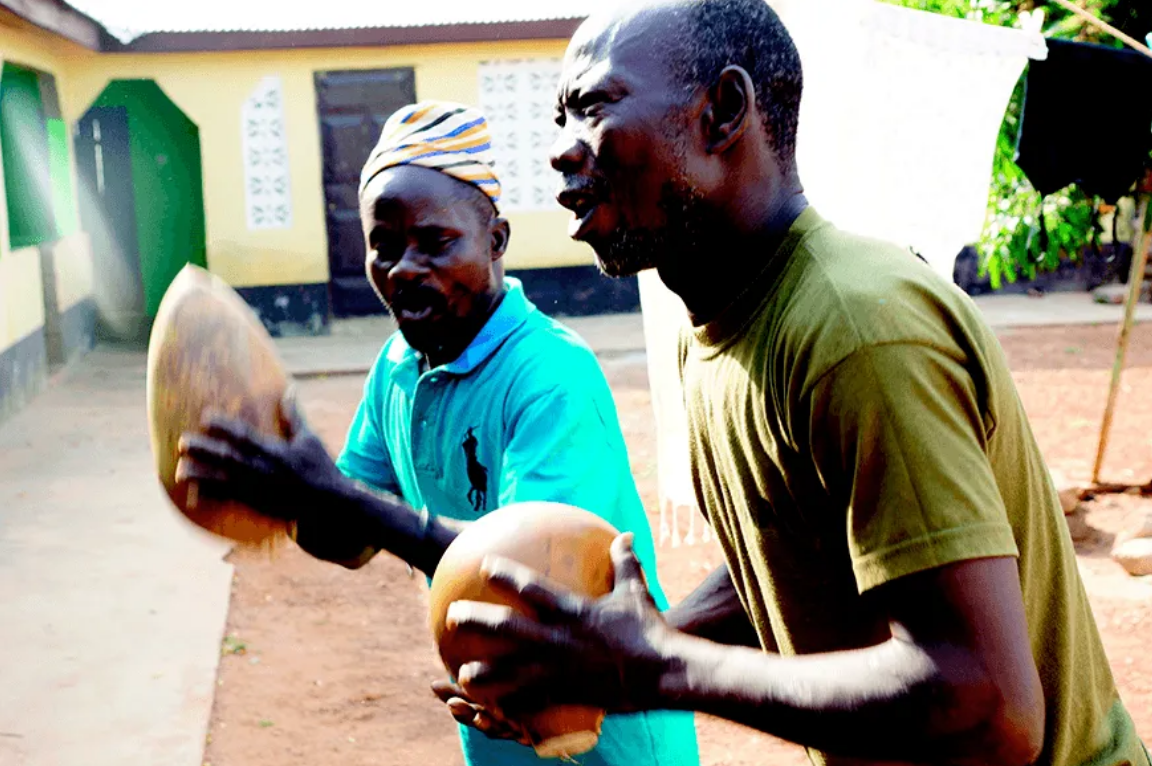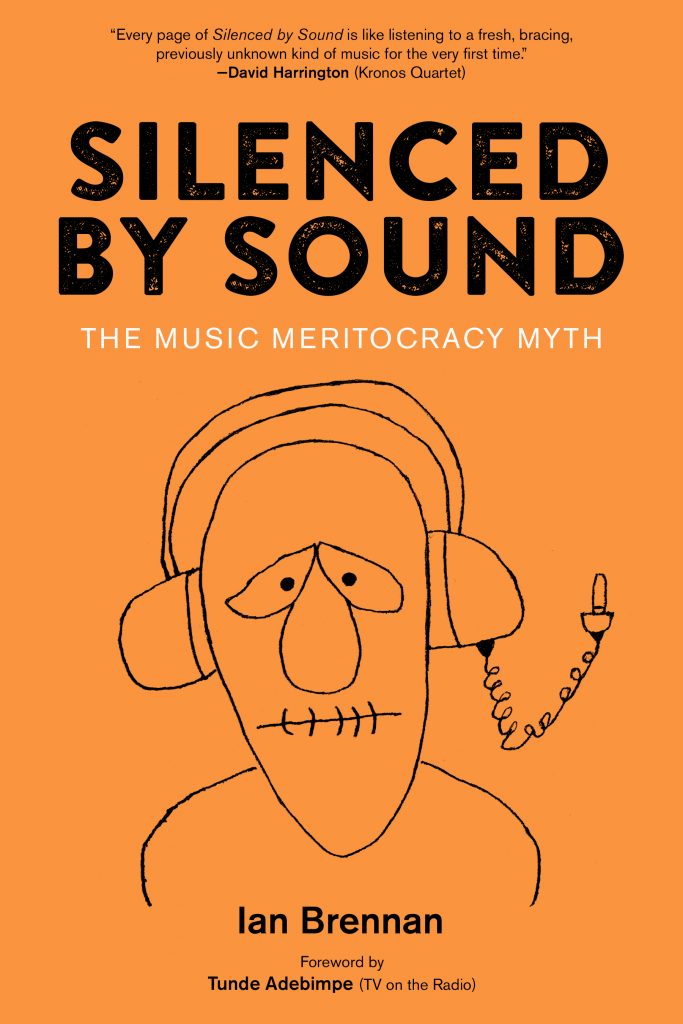
A Grammy-winning, world-traveling producer makes the case for looking beyond technology and academia for rhythmic and musical inspiration.
By Ian Brennan, Photos by Marilena Umuhoza Delli
Modern Drummer
October 2020
A sage, veteran live-sound engineer in San Francisco used to joke that he could already tell how much a drummer was going to suck by how many pieces of gear he loaded in. (Clearly, a fan of Rush he was not.) Similar logic has been reflected by many producers I’ve met who often strip a kit of cymbals and toms to force overly busy players to focus on the spine of a song.
But there are no instrument-less environments. All objects and surfaces contain stored harmonic energy. Increasingly when doing field recordings outdoors, I use found objects from the immediate environment as accompaniment—with the Good Ones in Rwanda it was bandleader Adrien Kazigira’s farm’s milk can that became a triangle; with the Oakland Homeless Heart, they banged on a park bench as a de facto 808; and the Afar people on the Red Sea shook boxes of matches for maracas.
We don’t necessarily need to tweak music with dials and processors. It can arrive already pre-tweaked and colored by its specific natural environment and the irreproducible material from which it is made.
Despite the trend towards urbanization, almost half of the world’s citizens continue to live in rural areas. There are no Guitar Centers or Thomanns positioned handily around the corner (or even within entire nations), so for many, building instruments becomes a mandate, not a hobby.
Since 2010 I’ve produced twenty-eight international albums from across four continents, in Pakistan, Rwanda, Ukerewe Island, Romania, Puglia, Tuva, Cambodia, and the newest nation in the world, South Sudan. The focus has been on trying to provide platforms for internationally under-represented regions, with a particular emphasis on working with those who have historically even been censored and persecuted, such as genocide survivors in Rwanda and Cambodia, and prisoners at the overcrowded maximum-security Zomba Prison. Many of these records have resulted in the first widely released albums of original music in their respective languages.
It has been theorized that the genesis of toolmaking might not have been for hunting, but for music making. In the least, it is clear that most hunting weapons served a secondary purpose to create sound (e.g., the bow). And the genesis of so many instruments is repurposed household items like pots and pans, saws, washboards—using whatever is at hand.
A little discussed fact is that a huge chunk of the instruments in the world derive from a single source, the calabash fruit tree. From the Philippines to Brazil to India to the Congo to Hawaii to China, dried calabash shells provide the material for soundboards and carrying water—both life-saving necessities. Musical life throughout the world has literally been shaped by agriculture, and it’s impossible to envision what it would have been were it not for this one plant.
The Tuareg in northern Africa play the calabash with their fingertips to mimic camel hooves, whereas for the Fra Fra in northern Ghana they serve as dueling football-size shakers. In Cuba, they even use dried calabash for coffee cups—delivering another element that many people would claim is also a necessity for survival, caffeine.
Some human needs are so great that the same technologies emerge in parallel as a near inevitability, permeating nearly every corner of the globe. For instance, there are very few places where some sort of unleavened flat bread cannot be found—injera in Ethiopia, Native American fry bread in New Mexico, lavash in Armenia. This dissemination is also the case with another flattened object: frame drums. Like most folk instruments, frame drums originally served a dual purpose: chaffing wheat by day, jamming at night. Whether dubbed a crowdy-crawn in Cornwall, pandereta plenera in Puerto Rico, or uchiwa daiko in Japan, another thing these instruments share is that almost every region claims that theirs is the original and “best.”
What is certain is that frame drums are one of the most ancient instruments—and arguably the first type of drum—ever made. The uniting factor across regions is the width always being greater than the depth. Thus, it is planar and often resembles an oversized tambourine.
Some instruments so transform a culture that it’s hard to imagine a time when they didn’t exist. Jo Jones, from Count Basie’s band, introduced the foot pedal for the hi-hat cymbal, and now it’s indispensable. Merle Haggard’s bandleader, Norm Hamlet, regaled me once about how, as an early architect of pedal steel guitar, he had to mail away for parts and hot-rod his own, since no complete model was manufactured yet for retail.
But owning an instrument does not make someone a musician. Some of the most musical people I’ve ever met have never touched one. Nonetheless, they live musically—every moment, every day. Virtuosity is not necessarily a virtue. With specialization and automatization, the question becomes: Yes, you are a drummer, but are you a musician?
Below are some of the ingenious and resourceful ways that I’ve had the honor of witnessing people keep time around the world.


Tanzania
The Tanzania Albinism Collective was composed of individuals from a group of people who have been systematically abused and even murdered due to their skin condition. No one on the record [White African Power] had ever tried to play an instrument or sung publicly before. In fact, due to social ostracization, most had been actively discouraged from singing or dancing throughout their life.
For the recordings, we utilized as a kick drum a ruptured rain barrel that stands taller than a person and can only be encircled by six people joining hands. It radiated subs that most low riders would die for. A pick-axe striking concrete acted as snare.
Malawi
An example of non–mass manufactured instruments’ value is the Malawi Mouse Boys’ self-crafted, salvaged-parts, four-string guitar. At first they were highly resistant to bringing the instrument on their first tour of Europe. They were ashamed and wanted to play “real” instruments instead. It didn’t take them but one gig, though, to appreciate that the rudimentary piece of equipment that had earned them so much castigation at home instead leant a certain cachet overseas.
Seeing fans line up to snap photos of their hand-painted, tree-branch “rig” as it rested alone against a wall following their inaugural show only solidified their newfound appreciation of such a dowdy instrument. So much so, in fact, that when we next returned to Malawi, the band had sold most of the Western factory-made guitars that we’d given to them as gifts and used the money instead to construct a mini-armory of funky, one-of-a-kind stone and scrap-metal playthings.
The Malawi Mouse Boys build drums from animal-skin heads and fashion tin-and-wire cymbals. The hi-hat itself is made from two stacked bicycle spokes, while sticks and stones also provide critical material—quite literally putting the rock back into rock music.
South Sudan

The heart of the South Sudanese Zande village is a xylophone that is more than ten feet long and requires five people to play it simultaneously. With sacred wood carried from three countries away in Africa, the kpaningbo is built in the center of the village, and it is so immense that it cannot be moved henceforth. (Never again will complaints from weekend warriors about having to shlep around trap kits ring quite true!) The core of the group’s instrument—thirteen keyed bars of varying lengths—are stacked just a matter of inches off the ground.
Similar to encounters I’d observed elsewhere, an ingenious example of recycling here was the use of Igloo coolers as tom drums (news that may or may not be music to the ears of certain refrigeration-industry executives). The musicians held these between their thighs as they shuffled about, spurring on dancers.
The bass drum itself is manufactured from half of a hollowed-out tree trunk. It is so large that the player must sit atop its concave shell and use their entire leg to alter the tone by opening and closing the sound hole via the bending and raising of their entire limb at the knee. The activity is so tiring that over the almost two hours of playing, a crew of musicians rotated to hop on and off, trading the role mid-song, without ever once losing the beat.

Ghana

Once in Ghana we witnessed a “wizard” family of five play the near equivalent of a complete drumkit, but with each age group responsible for just one of its pieces. The youngest member used a cellphone for a mallet. They’d restored the instrument to its source, as it was before collectivity imploded in the early days of the Industrial Age and drum corps shrunk to piecemeal, one-person affairs. Prior to that, it took an entire village to raise a raucous.
Vietnam

Master Xuân Hoạch is a prolific instrument builder, and his two-room home is stuffed with various one-of-a-kind pieces. Whammy bars are found on many of the instruments, a technology that dates back to the ninth century there. (Vietnamese culture had a massive head start on the American surf guitar genre.) Those who dismiss Asian music as without a discernible beat have simply missed the intricacy. Though Xuân Hoạch is elderly, his age was belied when he picked up a đàn nguyệt (two-string lute) and began banging out complex and stuttering wood-block syncopations with his two percussion foot pedals—like an aggro drunk person staggering forward, but never quite falling.
The Sound Within
A radical act of creation is to play everything but prescribed instruments. For ultimately, we are the instrument. I once saw the now ninety-five-year-old jazz legend Roy Haynes appear with an overly reverent, undercooked band in a Parisian club. After more than an hour of languidness, the band stopped and he suddenly let loose a hurricane solo, using only the parts of the drumkit that you aren’t supposed to play. It was as if a wrongly accused man had come uncuffed.
We need not so much to invent new instruments, but to find new voices within each existing one, beyond their stereotyped usages. Anywhere we go we have access to the original bass drum—our stomping feet—and the backbeat of clapped hands. All instruments at birth are first and foremost speech surrogates, attempts to bridge the communicational divide.
Ian Brennan is a Grammy-winning music producer who has produced three other Grammy-nominated albums. He is the author of four books and has worked with the likes of filmmaker John Waters, Merle Haggard, and Green Day, among others. His work with international artists such as the Zomba Prison Project, Tanzania Albinism Collective, and Khmer Rouge Survivors, has been featured on the front page of the New York Times and on an Emmy-winning 60 Minutes segment with Anderson Cooper reporting. Since 1993 he has taught violence prevention and conflict resolution around the world for such prestigious organizations as the Smithsonian, New York’s New School, Berklee College of Music, the University of London, the University of California–Berkeley, and the National Accademia of Science (Rome).






